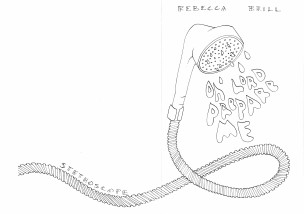
At the multi-faceted student-run Stethoscope Press, students of all different majors and class years get the opportunity to hone their writing skills, collaborate with student editors, and publish a book by the end of each school year, regardless of whether or not they are formally involved in the writing scene at the University. This year, Stethoscope Press will publish a play, an ethnography, two poetry/prose books, and two memoirs by six student writers.
Janika Oza ’15 chose to write about indigenous resistance to building a hydropower dam in Nepal in a creative nonfiction narrative entitled “From the Mouth of the River.”
“I wanted to explore larger ideas about the effects of large development on local communities,” Oza said. “I studied abroad in Nepal a year ago and interviewed people who would be affected by the dam. I was really moved by everything I was learning. The power of their stories made me want to figure out a way to share their opinions and lift up those voices.”
After piecing together transcribed interviews, Oza worked with student editor Hailey Sowden ’15 to determine which pieces of these stories to put in the final version of Oza’s book.
“I offered suggestions about how to organize things and how to make her great ideas reader-friendly,” Sowden said.
In a memoir entitled “Oh Lord Prepare Me,” Rebecca Brill ’16 cathartically explored the formation of identity in high school in the genre of confessional memoir.
“The book has a sardonic, wry tone and is divided into five chapters, each based around a theme,” Brill said. “My editor and I would go over it to decide what we wanted to keep and what needed re-working. In terms of the writing process, I also had to transcribe my high school journal, which was both a painful and funny experience in itself.”
Ethan Tucker ’15 also used his journals in his prose/poetry book “Modern Pilgrims” in an effort to fully illustrate his experiences during a 500-mile walk in Spain called the Camino de Santiago, which, in recent years, has been experiencing resurgence in popularity.
“I wanted to explore in a lyrical and spiritual way the concept of pilgrimage in the contemporary era and what it means to be a modern person walking such an old pilgrimage,” Tucker said. “The book ended up in a very different form than I had initially thought. For me, it was a big revision process.”
Admitting that it was sometimes difficult to leave out such formative personal experiences, Tucker worked with Amy Zhang ’15, who serves as one of Stethoscope’s head editors, in an effort to reduce material for a book that had a pre-set 52-page limit.
“One of the challenges for us was having a very clear, concise, and real account of what exactly he wanted to say,” Zhang said. “It was about finding his style because he had so much interesting material. I think he did a really good job finding his voice.”
Like Tucker, Kathleen Radigan ’17 also discovered how the writing process can alter an author’s vision of the end result while writing her own book of poetry, “You Guys are the Best Listeners.”
“I intended my book to be a collection of modern love poems, but it mutated into something darker,” Radigan wrote in an email to The Argus. “It ended up being about waiting and waiting for something to happen and the bizarre realizations that emerge.”
After writing her collection of poems, “Waiting Room,” Avigayl Sharp ’17 agreed that the process was full of unexpected twists and turns.
“The writing process is pretty bizarre,” Sharp wrote in an email to The Argus. “Sometimes things feel like you just scoop ideas up out of nowhere. It’s a lot more drudgery than you would expect, too, because you actually have to sit down, work, and think.”
Sharp worked with Kate Weiner ’15, Stethoscope’s other head editor, to fully formalize her poems.
“Because she came to me with such fully-formed poems, I mostly helped her figure out how to best position the poems in a way that they could best complement each other on the page,” Weiner said. “It was actually a lot more about structure than subject matter.”
In addition to writing and choosing how to arrange their content, student writers at the Stethoscope Press were also in charge of physically designing their own books.
“The amount of creative control that a student-run press like Stethoscope provides is incredible,” Sharp wrote. “It’s wonderful to really be able to create a beautiful thing from top to bottom.”
Although some student authors, such as Tucker and Oza, had to quickly learn how to use the Adobe Suite to design their books, other authors, like Gabe Gordon ’15, already knew how to bring their project into aesthetic reality.
“[Gordon] is a TA for graphic design classes, so he was able to design his experimental play ‘Paul Bunyan and Babe the Big Blue Ox in the Land of Gods and Monsters,’ a re-telling of the classic American tale, and its cover in a really beautiful way,” said Amy Mattox ’17, Gordon’s editor. “Formatting played a huge role in his book. He has a real skill with combining poetic sensibility with experimental play formatting and thinking simultaneously about life of the book on the page. The layout is definitely displayed in an interesting way graphically.”
Mattox remarked that Stethoscope provides a platform for students to creatively work on substantial and personal topics in a uniquely collaborative way.
“I hope that it can be an outlet for people who won’t necessarily get a chance to write long-form work and push themselves to write better outside of an academic setting,” she said.
The students’ books will be published on Saturday, May 9. There will also be a reading by the student authors on a date to be announced.


Leave a Reply